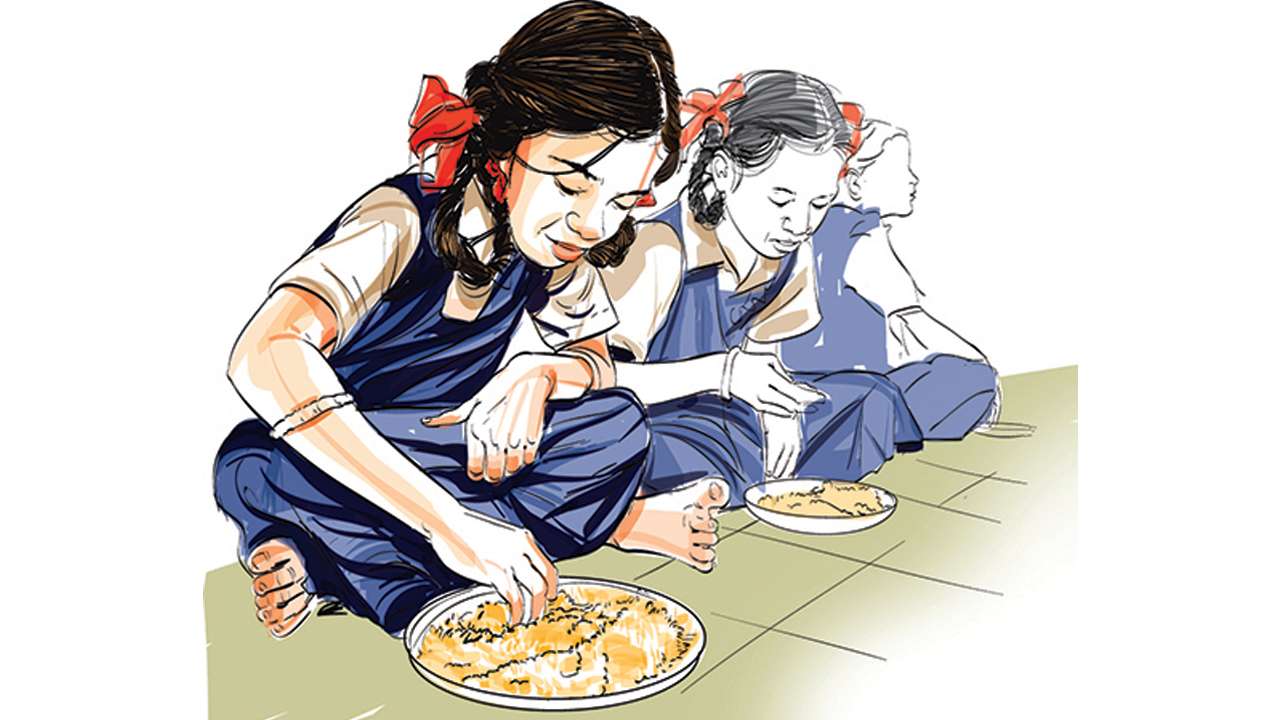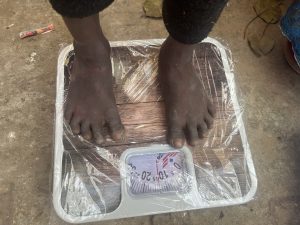Grave Hunger Crisis Stares India’s Most Marginalised: Hunger Watch Report

Two years into the pandemic, approximately more than two-thirds of Indian households surveyed across 14 states reported experiencing some kind of food insecurity, according to the findings of the second round of Hunger Watch survey.
The Hunger Watch survey, conducted between December, 2021, and January, 2022, by the Right To Food Campaign and the Centre For Equity Studies, aimed to track and document the hunger situation among vulnerable communities through in-person surveys. Socially and economically vulnerable households continue to reel under fall in income, food insecurity, and the lack of a comprehensive social security net, the report showed.
The first round of the survey, conducted in November 2020, six months after the first national lockdown, showed a ‘grave’ hunger situation. At the time, 62% of surveyed households had reported a drop in income, 71% a worsening in nutritional quality and 66% had reported a decrease in the amount of food consumed, compared to the pre-lockdown period. The situation has got worse since.
Some major findings from the second round are:
- Almost 80% of the surveyed households reported experiencing some kind of food insecurity. 25% reported experiencing severe food insecurity
- 66% households reported a fall in income during the pandemic
- Approximately 45% of households had outstanding debt
- One in six households reported that their children have dropped out of school
Higher Food Insecurity in Urban Areas and Among Muslims
The report used the Global Food Insecurity Experience Scale (GFIES) – a tool used to measure experience based food insecurity and hunger – developed by the Food and Agriculture Organisation of the United Nations to calculate food insecurity. The GFIES consisted of 8 questions such as whether the respondent was unable to eat healthy or nutritious food or whether they had gone a day without eating.
According to the Hunger Watch, each “yes” was given a score of one and each “no” was given a zero. An overall score ranging between 1 and 3 (out of 8) meant that the household experienced mild food insecurity, a score between 4 and 6 meant they experienced moderate food insecurity, and the score 7 and above meant they experienced severe food insecurity.
60% of those surveyed were worried about food, unable to eat healthy or nutritious food or unable to eat as many food items as they would have liked to, stated the report. 45% of the respondents reported that their household ran out of food in the month preceding the survey. Additionally, over one-third of the respondents felt that the situation would remain the same or get worse in the next three months.
The report used the Global Food Insecurity Experience Scale (GFIES) – a tool used to measure experience based food insecurity and hunger – developed by the Food and Agriculture Organisation of the United Nations to measure the levels of food insecurity. The survey uses indicators such as whether the respondent was unable to eat healthy or nutritious food or whether they had gone a day without eating.
Muslim households reported higher food insecurity. 87% Muslim households were precarious compared to 77% Hindu households.
However, Christian households (37%) were the ones that reported the highest levels of severe food insecurity followed by Muslim (35%) and Hindu (23%) households.
Among castes, Dalit households (29%) followed by Scheduled Tribe (27%) reported experiencing highest levels of severe food insecurity. 84% Dalit households and 81% general caste households reported experiencing any kind of food insecurity.
The highest proportion of households that reported going to sleep without eating belonged to general castes at 41%, followed by Scheduled Castes (36%), Other Backward Classes (29%), Particularly Vulnerable Tribal Groups (28%), and Scheduled Tribes (25%).
More urban (87%) than rural households (76%) reported facing any kind of food insecurity. 2 in 5 respondents said that the quality and quantity of their food intake had deteriorated as compared to pre-pandemic times. This was higher for urban households at 56% than rural households at 35%.
“There have been days when the whole family had to sleep without eating in the night due to lack of all ration in the household and the family was unable to afford it. We have not consumed eggs, non-veg or fruits in the last one and half months,” a woman respondent whose identity has been concealed was quoted as saying in the report.
The hunger situation becomes particularly concerning when the levels of malnutrition among women and children in the country are taken into account.
More than half of Indian children and women are anaemic, as per the latest round of National Family Health Survey (NFHS-5) released in November 2021. The NFHS was conducted before the pandemic. The prevalence of anaemia among children below the age of 5 has risen from 58.6% in NFHS-4 to 67% in NFSH-5 and that among women in the 15-49 years age group has risen from 53% in NFHS-4 to 57% in NFHS-5. At least 17 states and Union Territories have witnessed a significant increase in severe wasting among children under the age of 5 including Ladakh, Lakshadweep, Telangana, Nagaland, and Mizoram, where the numbers have nearly doubled since the last round of NFHS.
Reduced Income, High Debt And Health Expenditures
Close to one-third (32%) of the households reported that a member had stopped working or lost wages due to COVID-19, said the report.
The International Labour Organisation (ILO) had observed in 2020 that close to 40 crore informal workers in India were at risk of falling deeper into poverty during the COVID-19 pandemic. In April 2020, the unemployment rates in India shot up to 23.5% according to the Centre for Monitoring Indian Economy’s (CMIE) estimates. Additionally, 30 million Indians aged 20 to 29 were jobless, making up for 85 percent of the unemployed Indians, CMIE noted.
The bottom 25% of poorest households had debt burden worth almost four times their monthly household income, found the COVID-19 Livelihoods Survey of vulnerable households, conducted by Azim Premji University. An average Indian household lost approximately Rs 25,000 of their income in the first six months of the pandemic, it found. The earnings in the months of April and May 2020 fell by 40-50%, the survey noted.
More than half (59%) of those who reported income losses said that their income was less than half of pre-pandemic levels. Once again, this was higher in urban households (69%) compared to rural ones (47%), higher among Muslim households (65%) compared to Hindu households (51% ), according to the report. Among castes, general castes (63%), OBCs( 50%) and Scheduled Tribes (44%) saw the highest drops in incomes.
Fall in incomes has led to massive debts. 45% of the respondents reported being in debt ranging from 10,000 to 50,000, according to the report. Over one-fifth (21%) of these households owe a debt amounting to or more than 50,000 rupees.
23% of the household reported incurring a major health expenditure; 13% saying it was over Rs 50,000.
Uneven Access To Social Safety Nets
Only a little over a quarter (26%) of households had an earning member who had registered on the e-shram portal, a database of unorganised workers aimed at providing registered workers employment opportunities and benefits under social security schemes.
46% of the respondents who had received work under the Mahatma Gandhi National Rural Employment Guarantee Act (MNREGA) in the three months preceding the survey, had not received wages worth more than 15 days of work
82% of the respondents had a ration card and 90% of them received food grains they were entitled to by virtue of the ration card under the Public Distribution System (PDS) and the Pradhan Mantri Garib Kalyan Anna Yojana (PMGKAY), which made provisions for the distribution of free food grains as part of central government’s COVID-19 safety net.
29% households with members eligible for receiving payment pensions did not receive any amount, according to the report. Additionally, only 13% of the women eligible to receive entitlements under Pradhan Mantri Matru Vandana Yojana (PMMVY), a maternity benefits program run by the central government, received regular benefits. Behanbox had earlier reported on the inconsistencies under the ex-gratia payments of Rs 500 for three months starting April 2020, to women account holders of Pradhan Mantri Jan Dhan Yojana (PMJDY).
Impact on Children
18% households reported that their children have dropped out of schools and 6% reported that children under the age of 14 years in their households have entered the workforce.
Additionally, 28% households with mothers and children – who are most vulnerable to malnourishment – entitled to benefits under the Integrated Child Development Services (ICDS) reported not receiving the cash transfers. Close to a quarter (24%) of households with eligible members reported not receiving any Mid-Day Meal (MDM) transfers either in the form of cooked meals, dry rations or in cash, the report stated.
The MDM scheme has been subjected to constant budget cuts, as Behanbox had earlier reported. Last year the scheme was subsumed under and renamed Pradhan Mantri Poshan Shakti Nirman (PM-POSHAN). The 2021 budget allocation had seen a 38% budget cut in real terms. In FY 23, the budget under PM-POSHAN is rs 10,234 crore, which is 5.3% lower than the annual spending that was promised at the time of announcement of the scheme (rs 10, 812 crore).
Since not all households had children of school-going age or those under the age of 14, the impact of pandemic on children’s lives may be an underestimate of the on-ground reality, said the report.
What govt needs to do
Activists have demanded the universalisation of PDS so that subsidised food grains may be provided to anyone who demands it, and the expansion of quotas under the National Food Security Act (NFSA). They also demand for the extension of PMGKAY for the full duration of the pandemic with provision of edible oils and pulses to each household.
Government must revive hot cooked meals under ICDS and MDM along with the inclusion of eggs and nutrient dense diets in the meals and extend them to children under three years of age and to pregnant and lactating women, say activist groups.
The groups also demand a hike in wages of all workers providing care work, such as Anganwadi Workers and Helpers, Accredited Social Health Activists (ASHAs) along with decent working conditions.
We believe everyone deserves equal access to accurate news. Support from our readers enables us to keep our journalism open and free for everyone, all over the world.


